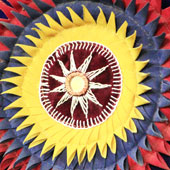Design Resource
Applique crafts
The Craft of Motifs on Textiles
by
Applique Work
It is believed that the origin and development of the appliqué work in Orissa dates back to ancient times. The appliqué craft originated in the district of Puri appointed artisans called Darji by caste as sevak- the people appointed by the king of Puri for looking after the day-to-day rituals of Lord Jagannath temple for regular supply of appliqué article required for the day-to-day seba (rites in the temple) of Lord Jagannath. In exchange of the seva, they were provided land ownership for their contribution of appliqué craft for the rituals of Lord Jagannath. During that time, the king also used to determine the quality and price of the appliqué craft to be procured from the suppliers. The available historical evidence on Orissa art and architecture suggest that the appliqué craft of Orissa dates back to the 12th century, when the temple of Lord Jagannath was built at Puri.
However, presently the appliqué work is not confined to any particular caste like “Darjee” rather the other caste people have mobilized into the profession along with the traditional castes in the clusters like Pipili and Puri. The main centre ofproduction is Pipili a small town in Khurda around 20 KM of the state capital. However, due to itsorigin from Pipili the craft is known all over as Pipili appliqué craft.Theappliquéproducts are also exported to many foreign countries.
• Motifs Used
The Pipili is famous for carefully cut shapes/ motifs of birds, flowers, leaves, and other geometric patterns. The different motifs used are basically belong to animals like Hathi(elephant), Singha (lion), and birds like Mayur (Peacock), Sua (Parrot), Gandamayur (doubleheaded peacock), Bataka (Duck), etc and the motifs of Gach (tree), Patra (leaf), Flowers like malli,padma (Lotus) are also used to decorate it. The beautifully shaped decorative motifs in chandua, the canopy make it more attractive. The use of motifs like, Suryamukshi at the centre of the product andgandamayur, which originated from the imaginations of the Pipili artisans make the Chanduaunique.














